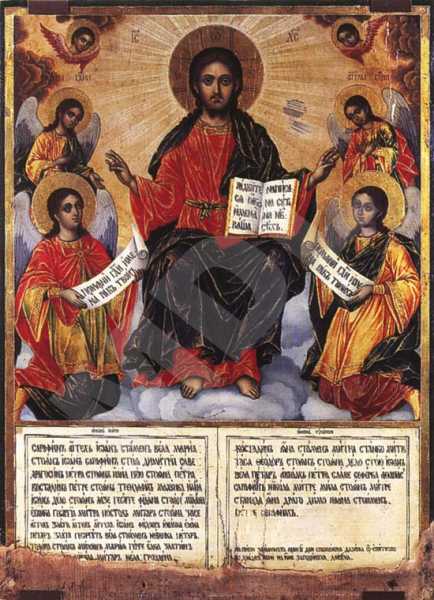Christ Pantocrator
Type:
Icon
Period:
From
the beginning of the
19 century
to
the end of the
19 century
Dimiter T. Molerov, born in 1780 in Bansko, son of Toma Vishanov the Moler. One of the best-known painters, a representative of the Bansko school of art, a disciple of his father, influenced by the art of Athos. Author of the murals of the naos in the St Archangels' paraclete in the Rila monastery, the murals in the Church of the Assumption of the Virgin in the Pchelino dependance. In 1840 and 1841 together with his son Simeon Molerov he paints the murals and the sponsors' portraits in St. Nicholas' and St. John of Rila's paracletes in the principal church in the Rila monastery. Among D. Molerov's major achievements in iconography are the following icons: St. Nicholas (1816) from St. Archangel Michael's church in the village of Leshko, Christ All-triumphant with Angels and Cherubim (1833), The Nativity and a Crucifixion from St Elijah the Prophet's church in the village of Usenovo. He has also worked in Belgrade on an invitation by Prince Milosh Obrenovich of Serbia. He died in 1870 in Bansko.
Dimmensions (cm):
69
/ 50
/ 2.5
Location
Country: Bulgaria
Province: Blagoevgrad
Town: Bansko
Museum: Museum complex
Source
Country: Bulgaria
Province: Blagoevgrad
Village: Osenovo
Church: St. Archangel Michael
Description
The iconographic cliche is the traditional one. Christ is portrayed seated, blessing with both his hands, with an open book leaning on his left thigh. Painted around him are four angels and two cherubs. The background passes gradually into clouds. Under the pictorial field the iconographer has left a certain place, divided in two, inscribed wherein are the names of the living and the deceased ones, which should be read during the worship.
Iconographical technique: Combined
The basic tones are in distemper, the brightenings on the figures in the composition and the lightings are done with a semi-oil vehicle.
Base material: Wood
The icon's base is a one-piece softwood panel, reinforced with two inserted beams. The ground coat is of plaster, about 1 mm thick.
State, restoration traces and comments
There are no traces of any previous restorative intervention.


